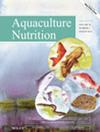发酵豆粕替代植物蛋白和鱼粉对大口黑鲈生长、肉质和肠道菌群的影响
IF 3
2区 农林科学
Q1 FISHERIES
引用次数: 0
摘要
本试验研究了发酵豆粕(FSM)替代豆粕(SM)、玉米蛋白粉(CGM)和鱼粉(FM)对大口黑鲈生长性能、肉品质和肠道菌群的影响。在添加400 g/kg鱼粉(FSM-0)的饲粮中,分别以添加100 g/kg (FSM-10-SM)、200 g/kg (FSM-20)和100 g/kg (FSM-10-FM)时,用FSM替代120 g/kg SM、120 g/kg SM + 80 g/kg CGM和65 g/kg鱼粉。然后选取体重为225.7±2.6 g的大口黑鲈饲喂4种饲料,饲喂60 d。FSM-20组的WG提高了11.8% (P <0.05),而FSM-10-SM和FSM-10-FM组的生长性能与FSM-0组差异不显著。与FSM-0组相比,FSM-20组肉质硬度、剪切力、总胶原蛋白、热溶性胶原蛋白和总游离氨基酸含量显著升高,FSM-10-SM组肉质硬度和剪切力也较高。FSM-20和FSM-10-FM组肉质超氧化物歧化酶(SOD)和总抗氧化能力(TAOC)活性以及FSM-10-FM组谷胱甘肽过氧化物酶(GSH-Px)活性均显著升高(P <0.05),而FSM-20组乳酸含量较FSM-0组降低(P <0.05)。血清生化指标方面,3个FSM组的葡萄糖、总蛋白、胆固醇和丙二醛含量以及FSM-10- sm和FSM-20组的甘油三酯含量均显著低于FSM-0组(P <0.05)。在肠道组织学上,FSM-10-SM组的肠绒毛宽度、肌肉厚度和FSM-20组的肠绒毛宽度均显著高于FSM-0组。在肠道菌群中,3个FSM组的厚壁菌门丰度高于FSM-0组,变形菌门丰度低于FSM-0组。综上所述,用100 g/kg FSM (FSM-10-SM和FSM-10-FM组)替代120 g/kg SM或65 g/kg FM对大口鲈的生长性能影响不显著,但部分改善了肉质。用200 g/kg FSM (FSM-20组)替代120 g/kg SM + 80 g/kg CGM,显著提高了大口黑鲈的增重和肉品质。本文章由计算机程序翻译,如有差异,请以英文原文为准。
Effects of Fermented Soybean Meal Substituting Plant Protein and Fish Meal on Growth, Flesh Quality, and Intestinal Microbiota of Largemouth Bass (Micropterus salmoides)
This study investigated the effects of replacing soybean meal (SM), corn gluten meal (CGM), and fish meal (FM) with fermented soybean meal (FSM) on growth performance, flesh quality, and intestinal microbiota of largemouth bass. In a diet with 400 g/kg FM inclusion (FSM-0), FSM was used to substitute 120 g/kg SM, 120 g/kg SM + 80 g/kg CGM, and 65 g/kg FM at the inclusion of 100 g/kg (FSM-10-SM), 200 g/kg (FSM-20), and 100 g/kg (FSM-10-FM), respectively. Then, largemouth bass weighing 225.7 ± 2.6 g was fed the four diets for 60 days. The WG of FSM-20 group was increased by 11.8% ( ), while FSM-10-SM and FSM-10-FM groups did not differ significantly from FSM-0 group in growth performance. Compared with the FSM-0 group, the flesh hardness, shear force, total collagen, hot soluble collagen, and total free amino acid contents of FSM-20 group were significantly increased, and FSM-10-SM group also presented higher flesh hardness and shear force. The flesh superoxide dismutase (SOD) and total antioxidant capacity (TAOC) activities in FSM-20 and FSM-10-FM groups and glutathione peroxidase (GSH-Px) activity in FSM-10-FM group were increased ( ), while the lactic acid content in FSM-20 group was decreased, when compared to FSM-0 group ( ). In serum biochemical indexes, the glucose, total protein, cholesterol and malondialdehyde contents in the three FSM groups, and the triglyceride content in FSM-10-SM and FSM-20 groups were significantly lower than those of FSM-0 group ( ). In intestinal histology, the intestinal villus width, muscle thickness in FSM-10-SM group and intestinal villus width in FSM-20 group were significantly higher than those of FSM-0 group. In intestinal microbiota, the three FSM groups showed higher abundance of Firmicutes and lower abundance of Proteobacteria than FSM-0 group. In summary, the replacement of 120 g/kg SM or 65 g/kg FM with 100 g/kg FSM (FSM-10-SM and FSM-10-FM groups) did not exhibit significant effect on growth performance, but partially improved the flesh quality of largemouth bass. The substitution of 120 g/kg SM + 80 g/kg CGM with 200 g/kg FSM (FSM-20 group) significantly improved weight gain and flesh quality of largemouth bass.
求助全文
通过发布文献求助,成功后即可免费获取论文全文。
去求助
来源期刊

Aquaculture Nutrition
农林科学-渔业
CiteScore
7.20
自引率
8.60%
发文量
131
审稿时长
3 months
期刊介绍:
Aquaculture Nutrition is published on a bimonthly basis, providing a global perspective on the nutrition of all cultivated aquatic animals. Topics range from extensive aquaculture to laboratory studies of nutritional biochemistry and physiology. The Journal specifically seeks to improve our understanding of the nutrition of aquacultured species through the provision of an international forum for the presentation of reviews and original research papers.
Aquaculture Nutrition publishes papers which strive to:
increase basic knowledge of the nutrition of aquacultured species and elevate the standards of published aquaculture nutrition research.
improve understanding of the relationships between nutrition and the environmental impact of aquaculture.
increase understanding of the relationships between nutrition and processing, product quality, and the consumer.
help aquaculturalists improve their management and understanding of the complex discipline of nutrition.
help the aquaculture feed industry by providing a focus for relevant information, techniques, tools and concepts.
 求助内容:
求助内容: 应助结果提醒方式:
应助结果提醒方式:


